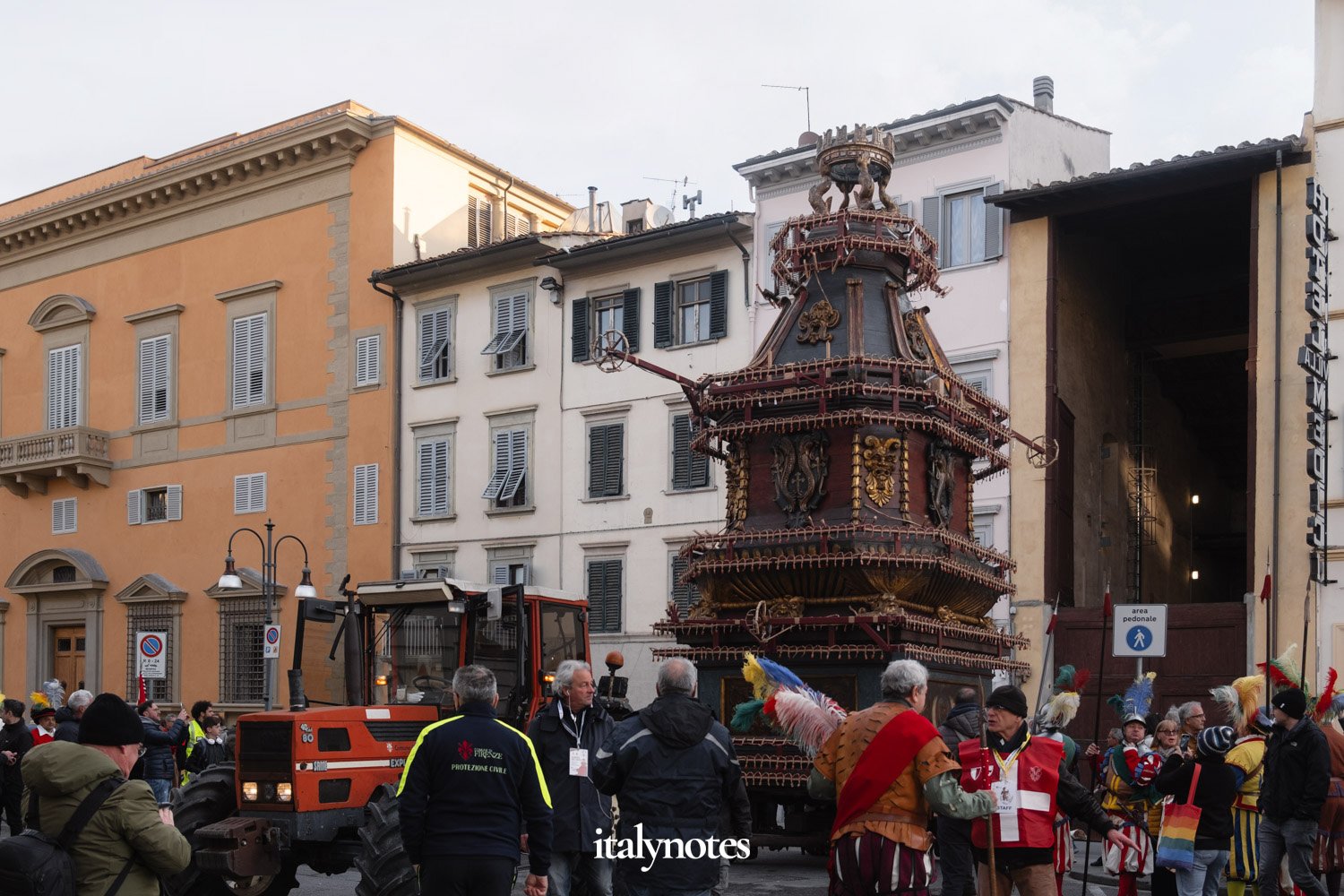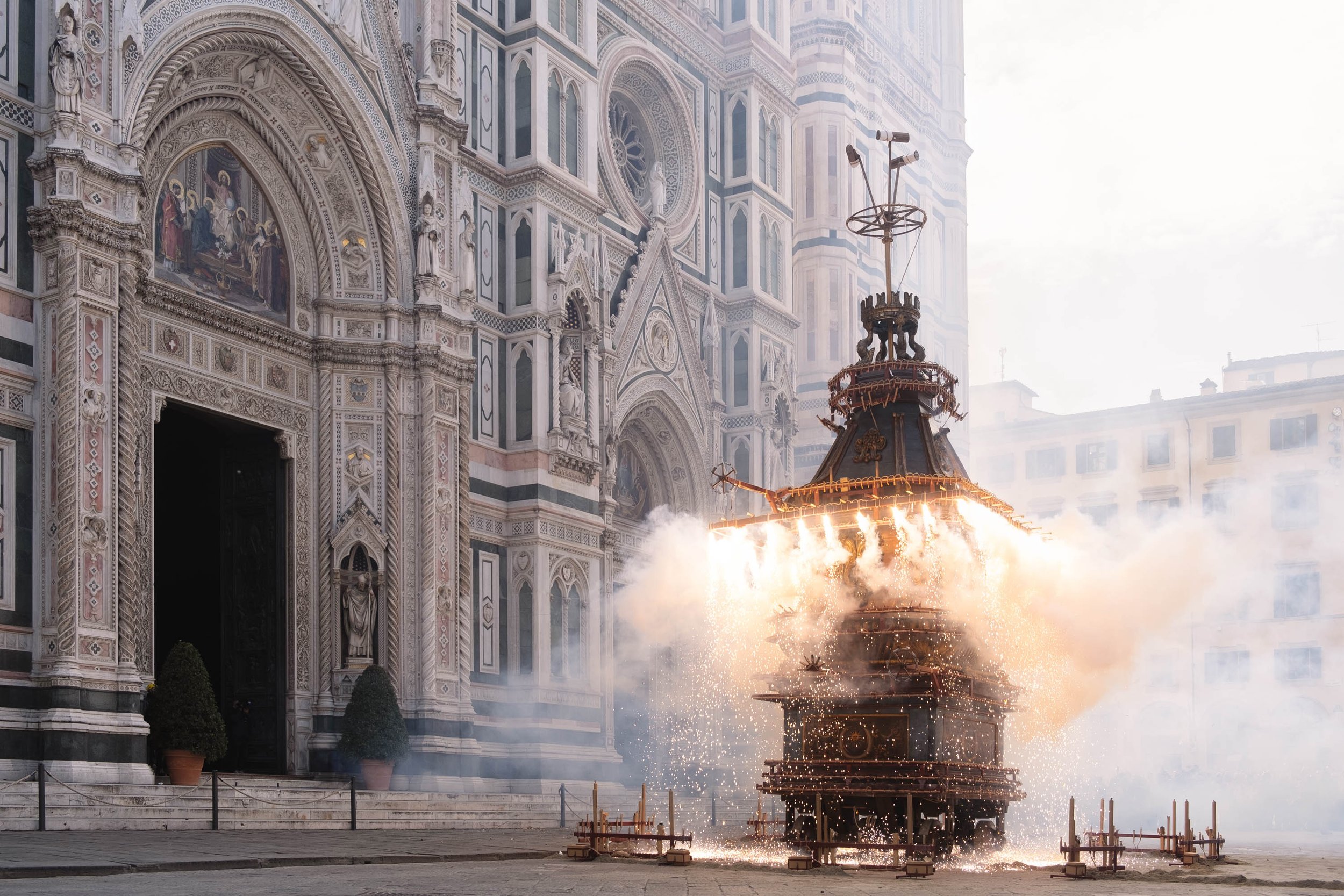Scoppio del Carro: an explosive Easter Sunday in Florence
Last updated: May 2023
After attending the Procession of the Dead Christ in Gubbio, I hopped on a train to Florence, where another ceremony awaited me. I'm talking about the Scoppio del Carro, also known as the 'Explosion of the Cart.' Let me share the history of this century-old tradition and how it ignited my Easter with a loud bang.
The Scoppio del Carro takes place right in front of the Santa Maria del Fiore, or Duomo di Firenze.
Back to the First Crusade
The origins of the Scoppio del Carro can be traced back to the First Crusade, which lasted from 1096 to 1099. It was the first of a series of religious wars initiated by the Catholic Church. The goal was to regain control of the Holy Land from Islamic rule.
On July 15th, 1099, the Crusaders achieved a significant victory by capturing Jerusalem. Legend has it that a young Florentine named Pazzino de' Pazzi played a crucial role in this triumph. It is said that Pazzino was the first to climb Jerusalem's walls and raise the Christian banner above the Holy City. Impressed by his bravery, Godfrey IV de Bouillon rewarded Pazzino with three flints from the Holy Sepulchre (the tomb of Jesus).
Pazzino later brought these stones back to Florence, where they are now preserved at the Chiesa dei Santi Apostoli e Biagio (Google Maps).
The start of a new tradition
But how does the heroic story of Pazzino relate to the Scoppio del Carro? In Florence, it was a long-standing tradition to extinguish all fires on Good Friday to honor Christ's suffering. Two days later, on Easter Sunday, the fires were re-lit to symbolize His resurrection. And what better way to ignite the 'holy fire' than with Pazzino's flints from the Holy Sepulchre?
The construction of the Duomo started in 1296, but the iconic facade was completed only in 1887.
The fire was then taken to the church for a blessing. From there, groups of men distributed it throughout the city, spreading the symbolic light of Christ's resurrection.
Over the years, more splendor was added to the festivity. At first, a decorated cart was introduced to transport the sacred fire to the church. Subsequently, with the advent of gunpowder, the celebration became even more exciting, resulting in the annual destruction of the cart with explosives!
This custom continued until fireworks replaced the use of gunpowder, and a permanent, sturdier cart was built. The new cart, named the 'Brindellone,' became the centerpiece of the festivity and remains the same cart used today.
On Easter Sunday the Brindellone is placed in front of the Duomo (top). The archbishop Giuseppe Betori then blesses the Brindellone (left). As part of the century-old tradition flag throwers, drummers and city representatives gather in front of the Duomo, all dressed in historical costumes (right).
But the innovations didn't stop there. One of the most creative additions came in the early 1500s when Pope Leo X (Giovanni de' Medici) introduced the 'Colombina.' Believe it or not, but the Colombina is a dove-shaped rocket symbolizing the Holy Spirit. Take a moment to ponder that. A dove-shaped rocket representing the Holy Spirit... And the most remarkable aspect? The Colombina still plays a crucial role in today's Scoppio del Carro.
Once the Brindellone is positioned in front of the Duomo, an iron cable is stretched from a column (placed at the center of Duomo’s choir) to the cart. Subsequently the Colombina is attached to the wire.
Once the Brindellone arrives at the Santa Maria del Fiore (Duomo di Firenze), a cable is stretched from a column – placed at the center of Duomo's choir – to the Brindellone. Subsequently, the Colombina is attached to the wire.
In the meantime, a religious ceremony takes place inside the Battistero di San Giovanni. Following the ceremony, the Archbishop of Florence blesses the Brindellone and ignites the fuse of the Colombina rocket with the holy fire. Shortly afterward, the 'dove' shoots through the Duomo and sets off the fireworks outside.
According to the belief, when the entire process proceeds smoothly, it brings good fortune to the citizens of Florence.
The Colombina shoots through the Duomo (left) and ignites the firework outside (right).
One of Florence's oldest traditions
The Scoppio del Carro is one of Florence's oldest traditions and has only been canceled twice throughout history.
The first interruption occurred between 1478 and 1494. It resulted from the banishment of the Pazzi family due to their involvement in the assassination attempt on Lorenzo il Magnifico and his brother Giuliano de' Medici (who actually got killed). During this period, the ceremony was greatly missed. And so, when the Medici were (temporarily) exiled in 1494, the Scoppio del Carro was reinstated.
More recently, in 2020, the Scoppio del Carro was canceled due to the widespread impact of the COVID-19 pandemic. Fortunately, this year (2023), the ceremony returned in all its splendor, unrestricted by any limitations!
Scoppio del Carro 2023
In 2023, I had the opportunity to witness the Scoppio del Carro. I woke up early, filled with anticipation, and headed to Via il Prato. Tucked away halfway down this street is a small warehouse (Google Maps) where the Brindellone is stored throughout the year.
It takes a tractor to maneuver the Brindellone out of the warehouse.
When I arrived, they had just started to open the wooden doors of the warehouse. Given the doors' immense size, this proved to be quite a challenging endeavor! However, after approximately 15 minutes, the doors were fully opened. With the assistance of a tractor, the Brindellone was carefully maneuvered out of the warehouse.
As the Brindellone slowly rolled out of the warehouse, its imposing size became apparent. Being about 9 meters tall, it easily towered over the crowd.
The Brindellone is about 9 meters tall and towers over the crowd.
Around 7:45, four white Chianina oxen made their appearance. Their horns were painted gold for this special occasion, and they wore floral headpieces. While my knowledge of plants and flowers is limited, I believe most of the flowers were lilies. This choice would make sense, as Florence is often called 'la città gigliata' (the lily town), and the lily has been the city's symbol for over 1,000 years.
The horns (and hooves) of the four oxen were painted gold and they wore floral headpieces.
The oxen were harnessed to the Brindellone, and soon they began to pull the cart forward. They proceeded through Via il Prato, heading towards Piazza della Repubblica, Via Roma, and ultimately arriving at Piazza Duomo. Along the entire route, they were accompanied by soldiers, musicians, flag throwers, and various individuals adorned in historical costumes reminiscent of the 15th century.
At the end of the event, the oxen will transport the Brindellone back to the warehouse located on Via il Prato.
As the procession move through the city, I hurried to Piazza Duomo to await the Brindellone's arrival. Thankfully, I had been granted a press pass. This allowed me to observe the preparations taking place both inside and outside the Duomo while I waited.
As part of the century-old tradition flag throwers, drummers and city representatives gather in front of the Santa Maria del Fiore, all dressed in historical costumes.
At 11:00, the moment was finally there. The Brindellone and fireworks were installed. Showtime! Archbishop Giuseppe Betori lit the fuse of the Colombina, and the rocket-dove rushed through the Duomo to the Brindellone.
Within seconds, the Brindellone burst into action, emitting sizzling, crackling fireworks that spewed from all sides. This eruption continued for about 20 minutes! And even though the fireworks may not have been overwhelmingly spectacular, the entire atmosphere turned the Scoppio del Carro into an absolutely one-of-a-kind (yet noisy) experience that left an unforgettable impression. So, if you happen to be in Florence next Easter, don't miss out on this unique festivity!
The Brindellone burst into action, emitting sizzling, crackling fireworks that spewed from all sides.




















